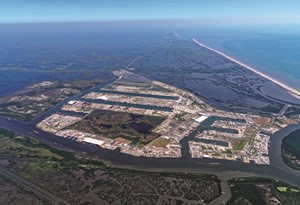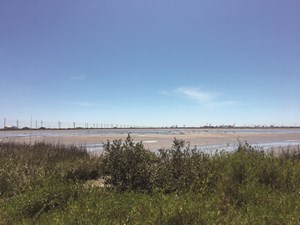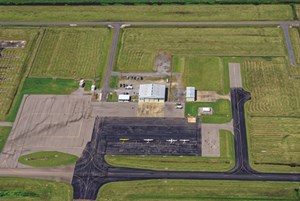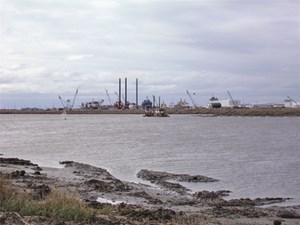Designing a future with “holistic resilience”
With rigs on standby, awaiting active duty in the deepwater Gulf of Mexico (GOM), the management of southern Louisiana’s resilient Port Fourchon is locked firmly in the visionary mode.

Amid signs of an uptick in deepwater activity, sooner rather than later, the governing Greater Lafourche Port Commission (GLPC) is progressing at full throttle toward developing the next generation of port facilities. Port Fourchon is well-established as the premier service-and-supply center for the deepwater GOM oil and gas industry. In addition, groundwork laid with separate agreements signed in late 2016, to increase drafts and build a floater repair facility, should bear fruit this summer. Coinciding with the 17-year-old Northern Expansion development campaign, the long-range master plan is encapsulated in a philosophy of holistic resilience, in which industrial development and environmental stewardship are mutually inclusive.
“We’re focused on taking care of our current business, while also planning for future deepwater needs,” says Port Fourchon Executive Director Chett Chiasson. “The whole idea of holistic resiliency is that we can have a working coast, with a vibrant oil and gas industry that continues to provide jobs, while protecting our coast at the same time. Basically, we recognize the threats we have, when it comes to subsidence or impacts from hurricanes, and we combat those threats by both designing our facilities and infrastructure to higher and harder standards, but also utilizing strategic wetland restoration in areas which provide natural protective benefits for our industrial asset base from these threats.”
Highlighting the working component of the development philosophy of this once-inaccessible marsh in Lafourche Parish is the planned development of the Gulf Coast’s first purpose-built deepwater rig repair and refurbishment facility at Fourchon Island, immediately south of the port proper. Chiasson said the commission hopes to have a signed lease by May on the 900-acre site where, if all goes as planned, construction of the rig repair facility could begin by 2020. “If a rig has been operating in the U.S., we want to see that it stays in the Gulf of Mexico, and does not leave to get refurbished in a foreign yard,” Chiasson has said.
Hand-in-hand with the planned repair facility is the fast-tracked completion of an exhaustive study, to determine the economic and environmental feasibility of deepening the channels throughout the port to accommodate super-sized vessels, Fig. 1.
PUSHING THE PLAN
The port commission hopes to have the results of the feasibility study by summer, effectively clearing the way for the next phase of deepening channel drafts throughout much of the port. The two-pronged study is being conducted by the port commission with the cooperation of the U.S. Army Corp of Engineers, under the auspices of Section 203 of the U.S. Water Resources Development Act of 2000. Authorized by the memorandum of understanding (MOU) that the GLPC signed in August 2016, the comprehensive study was originally estimated to take up to three years, but it was fast-tracked, given President Donald Trump’s call for national infrastructure improvements. “We pushed for the study to get completed earlier and, hopefully, allow us to capitalize on what the (Trump) administration is doing with respect to infrastructure,” Chiasson said.
The more complex of the two elements included in the feasibility study examines deepening, in 5-ft increments, the nearly 5-mi main channel that links Port Fourchon to the Gulf of Mexico to between 35 and 50 ft. Once authorized and completed, Chiasson said the deepening project would mostly provide a 50-ft draft from the Gulf and up to Belle Passe, at the intersection of Bayou Lafourche and Pass Fourchon, the eventual home of the deep-draft rig repair facility. “No matter what, our future is on Fourchon Island, regardless of the (results) of the feasibility study,” Chiasson said. “We’ve grown the port so much in the last 30 years, this seems like our next natural progression of development.”
The study also is examining the feasibility of increasing the depth of the channel running from Belle Pass into Bayou Lafourche and up to the ongoing Northern Expansion development area. The channel is now authorized for a 24-ft draft, but with 3-ft advanced maintenance, essentially provides a 27-ft draft. The GLPC wants to deepen the channel up to 30 ft, from Belle Pass, into Flotation Canal and up to the Northern Expansion slips.
“Our indication is that the feasibility study will conclude that a draft of 30 ft from Bayou Lafourche and into the Northern Expansion area, and 50 ft from Belle Pass and into the Gulf, will be economically and environmentally feasible,” Chiasson says.
He noted, however, that 30-ft drafts would only abut waterfront leaseholds along Bayou Lafourche and into the Northern Expansion, where, unlike those built during earlier phases of port development, the newer-generation bulkheads can accommodate deeper drafts with minimal retrofit. “We can dig the channel to 30 ft with no problem, and if a dock facility wants their bulkhead to handle 30-ft drafts, it would only require minimal retrofitting,” he said.
MESHING INDUSTRY-ENVIRONMENT
The centerpiece of the environmental component of the holistic resilience ideology is unfolding at a 95-acre pond alongside the primary access road into the industrial core of Port Fourchon, Fig. 2. There, material from the initial hydraulic dredging of Slip D, the newest slip under development, is being redirected from a typically isolated mitigation area, to create what can best be described as an interactive conservatory, which will be clearly on display upon entering the port. “When you talk about mitigation, it’s normally away from where people can see it. We’re developing an interactive mitigation area, right in the middle of the port, where people can truly see and understand what mitigation and coastal restoration is all about,” Chiasson says.

Once completed, the ambitious project, which has received the blessing of a number of environmental permitting agencies, will break up the industrial monotony with verdant native vegetation, interspersed with jogging trails and tidal creeks for kayaking and other aquatic recreational activities. Plans even call for the construction of a pavilion for hosting fishing tournaments, corporate functions and the like. “This is really an example of what we are doing to demonstrate how the industry and environment can work together. The oil and gas folks at the port are very interested and want to be a part of it,” Chiasson said.
While material recovered in the dredging of Slip D is being used largely for the uniquely accessible mitigation project, a much larger volume will be earmarked for rehabilitating the storm-ravaged coastline. In keeping with the holistic resilience vision, Chiasson said between 8 million and 10 million cubic yards of dredged material in the planned initiative will be dedicated to coastal restoration in the deepening project’s initial construction. There is potential for tens of millions more over the project’s maintenance dredging cycles, making it a truly renewable resource for the future of Louisiana’s working coast.
“Nearly half of that initial material will be made available for beneficial reuse and to help rebuild our coast. We’re working with all the environmental agencies, including the Coastal Protection Restoration Authority, and hand-in-hand with industry to help build up our fragile ecosystem,” he said.
“What we are doing very well is demonstrating how the oil industry and environment can work together to do the things we need to do businesswise, while also protecting the ecosystem which protects us,” Chiasson said.
CHANGING TIDE?
Meanwhile, mounting indicators suggest the persistent economic struggles of the offshore sector may be on the cusp of a recovery, providing oil prices continue to cooperate.
Wood Mackenzie predicts deepwater GOM oil and gas production to hit a record 1.935 MMboed in 2018, and major discoveries announced early this year raise hope of reviving the stubbornly-anemic rig count. As of March 16, Baker Hughes reported only 13 active rigs on location in the Gulf, down six from the same time last year. “The rigs are here. They’re just not all drilling,” says Chiasson, referring to no less than seven drillships stacked off Port Fourchon, pending a return to active status.
One sign implying that operators are gearing up to resume drilling comes from the latest data available from the U.S. Bureau of Safety and Environmental Enforcement (BSEE). Between January and February, BSEE approved 14 Gulf of Mexico drilling permits for waters deeper than 500 ft, compared to eight for the like two-month period in 2017.
The major deepwater discoveries that ushered in 2018 have further bolstered prospects of better times ahead. On Jan. 31, Shell Offshore proclaimed its Whale deepwater discovery on Alaminos Canyon Block 772, as its largest GOM exploration find in a decade. At the same time, Chevron and partner Total announced a significant oil discovery at the Mississippi Canyon Ballymore prospect in 6,536 ft of water. The discovery well targeted the Norphlet reservoir with a TD of 29,194 ft.
Prior to the back-to-back discoveries, Wood Mackenzie forecasted “2018 will be a forward-looking year for the (deepwater) sector, as it lays the foundation for longer-term resurgence in 2019 and beyond.”
“Although deepwater Gulf of Mexico has taken quite a beating over the last three years, the industry has clawed its way back to being competitive by significantly cutting costs, improving efficiencies, and tightening up the supply chain,” Senior Research Analyst William Turner wrote on Jan. 4.
Chiasson agrees, providing oil prices stabilize in at least the low-to-mid $60s/bbl range. “Things are absolutely looking much brighter than they were last year. I’m optimistic about the second half of this year and going into 2019. We’ve seen increased activity at our tenants’ facilities over the past six months. It’s still not great, but it’s coming,” he said in mid-February.
Further evidence of improving fortunes comes from three new waterfront leases signed in second-half 2017. New leasees, Omni Energy Services Corp, Oceaneering International and FCC Environmental Services, join 80 previously entrenched companies holding more than 140 leases across nearly 2,000 developed acres. “These were the first waterfront leases we’ve signed in three years,” Chiasson said. “Getting those three waterfront leases is a big deal, and a great sign going forward.”
Although the market for offshore support vessels (OSV) remains sorely depressed, he says that “help wanted” solicitations are re-appearing. “Locally, we’re seeing some ads for deck hands, seamen and the like. We haven’t seen that in a long time.”
For now, port tenants more acclimated to servicing and supplying deepwater drilling are getting a boost from the construction projects underway throughout the Gulf. As Shell celebrates the Whale discovery, for example, construction work is underway on its Appomattox, Kaikias, and Coulomb Phase 2 deepwater projects. “What’s taking place on the construction side is going to bridge the gap a little bit. At least, that’s what we’re seeing now,” Chiasson said.
Notably, the long-dormant shelf, likewise, is showing signs of life with two privately held operators snatching up Chevron’s shallow-water assets in separate transactions. “The (shelf) companies are starting to do some work on their platforms, along with some pipeline and other ancillary work,” Chiasson said.
Start-up company Cantium LLC in July acquired five Chevron fields in Bay Marchand and Main Pass, which includes 151 platforms and a Port Fourchon-based treatment plant. In April, Cox Oil Offshore LLC picked up 19 shelf fields from the super-major, comprising 170 producing wells and 70 platforms. They join established shelf producer Energy XXI Ltd, which plans to drill six wells this year. As part of the company’s 2017 cost-cutting initiative, all onshore support is now handled out of Port Fourchon. “The consolidation of our Grand Isle operations with Port Fourchon has improved coordination, minimized cost, and reduced the manpower necessary to continue to operate the same properties,” COO Scott Heck told investors on March 16.
According to the latest statistics, offshore support activity at the port-controlled South Lafourche Leonard Miller Jr. Airport appears to be up modestly. The airport is home for 43 helicopters and 20 fixed wing aircraft, according to Manager Richard Osborne. In January, the airport served 9,326 passengers in 2,208 operations, up slightly from 9,263 passengers and 2,138 takeoffs and landings in January 2017, Osborne said.

After investing $30 million to construct what Osborne describes as a mini-commercial airline terminal, top tenant Chevron consolidated its Gulf of Mexico aviation operations at the airport. In mid-2017, RLC, the largest privately held helicopter operator in the Gulf of Mexico, expanded its foothold at the airport and proceeded to add four heli-pads and expand the parking to two acres, to accommodate its fleet and the additional demand, Fig. 3.
In a related development, some of the increased production that Wood Mackenzie forecasts could be headed outside the U.S., as the Louisiana Offshore Oil Port (LOOP) off Port Fourchon adds exporting to its already bustling import and domestic crude oil movement and storage business. In late February, LOOP LLC completed its first very large crude carrier (VLCC) oil loading operation, with Shell Trading Company U.S. (STUSCO) the shipper of record for the inaugural cargo.
The exportation of a markedly different commodity hinges on a favorable ruling by the U.S. Federal Energy Regulatory Commission (FERC). Early last year, Energy World USA announced plans to build a mid-scale liquefied natural gas (LNG) production and export facility on its nearly 143-acre lease, immediately west of Belle Pass and outside the core of Port Fourchon.
The designated Fourchon LNG complex will include a 2-million-ton/annum export terminal, as well as a smaller plant to provide fuel for next-generation LNG-powered offshore supply vessels. Chiasson said FERC permitting should take another 15 to 24 months before construction can begin.
Chiasson said in Feburary the proposed Fourchon LNG had “just recently” received approval from the U.S. Department of Energy to export LNG to free trade countries for 30 years and to non-free trade countries for 20 years, pending FERC approval of the facility.
KEEPING PACE
Concurrent with preliminary dredging for undeveloped Slip D, port personnel are busily preparing homes for the newest port arrivals. The 939-linear-ft bulkhead for FCC Environmental was recently completed on the west side of Slip C on a lease that runs up to one of the waterfront properties held by Edison Chouest Offshore. Also in Slip C, construction has wrapped up on the bulkhead for Omni Group’s 950-ft waterfront lease.

Of the 1,671 linear ft of bulkhead under construction on the east side of Slip C, Oceaneering holds a lease on 400 linear ft, in addition to 800 linear ft of long-available waterfront completed a couple years ago. The remaining waterfront footage is under a right of refusal to Newpark Drilling Fluids, which last year completed a wholesale face lift and expansion of its E-Slip supply base on a five-acre lease directly across from Chouest’s C-Port II covered facility.
While the initial hydraulic dredging of Slip D (Fig. 4) is building up the interactive mitigation area, the port is taking a measured development approach with this latest Northern Expansion project. The newest slip will eventually add 9,000 linear ft of waterside dock space. Chiasson said full-scale development will be carried out as demand warrants, which reflects the port’s overall development strategy.
“We don’t see it developing quickly, but we’re going to be ready at Slip D to meet the demand when it comes. Everything we do is to ensure there is no need for anyone to go anywhere else.” ![]()

- U.S. producing gas wells increase despite low prices (February 2024)
- U.S. drilling: More of the same expected (February 2024)
- Driving MPD adoption with performance-enhancing technologies (January 2024)
- Wellbore seal control and monitoring enhance deepwater MPD operations (October 2023)
- U.S. upstream muddles along, with an eye toward 2024 (September 2023)
- Advancing casing drilling to deepwater: Rethinking top hole well construction (August 2023)


